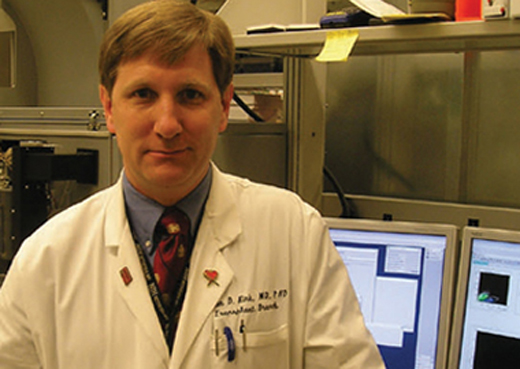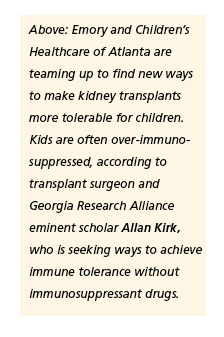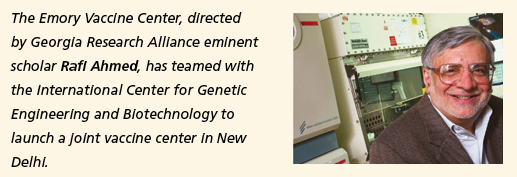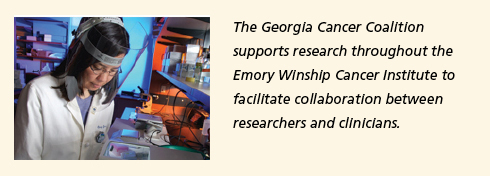Research: The value and promise of partnership

Emory medical researchers made outstanding, sometimes dramatic scientific advances last year. They received $332.7 million in sponsored research, including awards received by medical faculty at Yerkes National Primate Research Center and at the Atlanta VA Medical Center. From the NIH, Emory’s medical researchers received 501 awards (including Yerkes), for a total of $218 million. The work funded by these awards is premised on the value and promise of partnership.
In this section:
Unparalleled investments in pediatrics | The potential of predictive health
Expansion of clinical trials | Global partnerships
Improving transplantation | The carbohydrate connection
Protecting the mind | Fighting flu | Strategies against cancer
Unparalleled investments in pediatrics

The medical school's long-term partner in pediatric care, Children's Healthcare of Atlanta (which includes Egleston, Scottish Rite, and Hughes Spalding hospitals), recently designated $430 million of its endowment to pediatric research, citing a desire to leverage partnerships with Emory and Georgia Tech. This investment takes advantage of the large patient base in the Emory-Children's Center, a joint venture between Emory and Children’s that forms the largest pediatric multispecialty group practice in Georgia.
In a collaborative effort with the U.S. Department of Health and Human Services, Emory was awarded $25.5 million to participate in the National Children's Study. Medical school researchers, together with Emory colleagues in public health, are partnering with Morehouse School of Medicine and a technology development company to follow a representative sample of 100,000 children from birth to age 21, seeking information to prevent and treat problems such as autism, birth defects, diabetes, heart disease, and obesity.
The potential of predictive health
The Center for Health Discovery and Well-Being, part of the Emory-Georgia Tech Predictive Health Institute, began enrolling its first wave of 700 participants, collecting biologic, imaging, and survey data to learn how to predict, prevent, and reduce specific diseases.
The first areas of focus are oxidative stress, inflammation and other immune responses, and stem cell counts in the body's circulatory system. The institute supports more than 20 research projects on topics including biomarkers to predict risk of cardiovascular and neurodegenerative disease and cancer, prediction of drug treatment toxicity, and predictive health modeling in early infancy.
Expansion of clinical trials
New collaborative—The NIH awarded $31 million to Emory to support the Atlanta Clinical and Translational Science Institute (ACTSI), with the goal of speeding development of new treatments and getting them into clinical application more efficiently. The ACTSI is led by Emory in partnership with Morehouse School of Medicine, Georgia Tech, and Children's Healthcare of Atlanta. Other collaborators include the Georgia Research Alliance, Georgia Bio, Kaiser Permanente of Georgia, Centers for Disease Control and Prevention, and Atlanta VA Medical Center.
HIV and other infectious diseases—The Emory HIV/AIDS Clinical Trials Unit was selected as a component of both the premier national clinical trials group for new AIDS treatments and the national network for AIDS vaccine prevention trials. The Emory Vaccine Center's Hope Clinic was one of the top-enrolling sites for clinical trials of HIV vaccines sponsored by the HIV Vaccine Trials Network. Emory also was named one of the newest members of a group of vaccine and treatment evaluation units funded by the NIH to conduct clinical trials for all infectious diseases other than AIDS.

Global partnerships
The Emory Vaccine Center and the International Center for Genetic Engineering and Biotechnology (ICGEB) joined forces to launch a joint vaccine center in New Delhi. The center's research is focused on AIDS, tuberculosis, hepatitis C, dengue virus, malaria, and other infectious diseases that disproportionately affect the developing world. Emory will provide the funding to support scientific staff in the New Delhi center, and ICGEB will provide space and infrastructure. The new center is a primary focus of the Emory Global Health Institute, a university-wide initiative that fosters international partnerships to address health problems around the world.
Improving transplantation
Increasing the odds of success—About one-third of the patients on the national waiting list for kidney transplants have only a small chance of receiving a new organ. Because of prior transplants, pregnancies, or blood transfusions, they have developed antibodies that make matching them with donor organs very difficult. The Emory Algorithm, a decision process developed by Emory immunologists and transplant surgeons, uses assay technology—one that identifies a single antibody at a time versus general groups of antibodies—to predict which sensitized patient will be compatible with any given donor.
A recent study found that use of the algorithm raised the rate of transplant in these patients from 15% to 25% and that their survival rate was almost identical to that of nonsensitized patients.
New data library—A newly established Georgia Research Alliance-Emory Transplant Center Biorepository for Translational Science is helping researchers better link their discoveries in the laboratory to the care of organ transplant recipients. The biorepository allows for processing, storage, distribution, and clinical correlation of samples such as blood, tissues, and fluids critical for evaluating new clinical therapies and will become a robust library of conditions that can lead to organ failure.
The carbohydrate connection
Glycomics, or the study of carbohydrates, may hold keys to understanding what can go wrong in diseases ranging from flu to Alzheimer’s. Researchers in Emory’s glycomics center, which is part of the NIH Consortium for Functional Glycomics, are using glycomics as a window onto a wide range of inquiries. They have devised what they call "shotgun glycomics" to create microarrays to probe interactions of carbohydrates with other molecules. They are forming collaborations in glycomics to focus on predictive health and disease diagnostics. They plan to use carbohydrates found in the schistosomiasis parasite to develop vaccines against this and other diseases. And they are beginning to probe carbohydrates in the brain, a huge, unexplored universe of glycobiology.
Protecting the mind
Fragile X syndrome—Emory scientists now understand how a gene mutation alters the way brain cells communicate in this disorder, the most common form of inherited mental retardation. With drugs, they were able to reverse the effects of the mutation in neurons cultured from laboratory rats. They now are screening and identifying the best drugs to try and correct the deficiencies in fragile X in humans.
Autism—The same researchers working on fragile X also head a project funded with support from the Simons Foundation to uncover genes on the X chromosome that may contribute to autism. The ability to examine the entire X chromosome for abnormalities was technically infeasible until recently. Now, thanks to genomic technology developed at Emory, the researchers are performing a comprehensive search of the X chromosome in 300 patients with autism. If an X-linked variation for autism susceptibility exists somewhere among the 155 million base pairs of this chromosome, this survey should find it, an important first step to uncovering the true basis of this disease and developing diagnostic tests and therapies.
Emory's autism work got a recent boost from affiliation with the Marcus Development Center, which combines resources at Emory, Marcus, Children’s Healthcare of Atlanta, and Georgia Tech to diagnose, treat, and support children with autism.
Alzheimer's—A vaccine designed to slow the accumulation of amyloid plaques in the brains of Alzheimer's patients is now in testing at Emory, one of the first of a small number of medical centers across the United States and Sweden to offer the new vaccine developed by Merck. All medications now available to treat Alzheimer’s aim to improve the function of the nerve cells that remain alive after others are destroyed. This vaccine aims to prevent or slow the damage in the first place. Using a small piece of naturally occurring beta-amyloid protein, the vaccine is designed to harness the patient’s own immune system to produce antibodies against the protein.
Huntington's disease—Working with Emory geneticists, researchers at Yerkes National Primate Research Center developed the first transgenic nonhuman primate model of this disease, one of the most devastating of all neurodegenerative disorders, destroying physical, mental, and emotional control for 10 to 15 years before causing death. In the past, researchers had to rely on mouse models to study Huntington's. The primate model, coupled with powerful neuroimaging capabilities at Yerkes, is providing a more comprehensive view of the disease.
Fighting flu
Vaccine patch—Researchers from Emory and Georgia Tech received $11.5 million from the NIH to develop a product that can deliver flu vaccine through painless micro-needles in patches applied to the skin. Using patches instead of needles would not only reduce discomfort but also decrease costs and production time for vaccines. It could also make them more widely available in developing countries.
Stop-gap measure—Emory flu researchers also partnered with scientists from Oklahoma Medical Research Foundation to generate high-affinity monoclonal antibodies against flu virus, using blood samples obtained from human volunteers a month following vaccination. This method could be used to quickly generate human antibodies against a pandemic flu strain as a stop-gap therapy or to protect people from infection. In the face of a disease outbreak, the ability to quickly produce infection-fighting human monoclonal antibodies could be invaluable.

Strategies against cancer
From quantum dots to colloidal gold—Emory and Georgia Tech have long collaborated in work with light-emitting semiconductor crystals as a tool to detect cancer. These quantum dot crystals, each 100,000 times smaller than the diameter of a human hair, are fused with antibodies and released into the circulatory system where they grab onto tumor cells with matching antigens and then light up in response to a simple laser light. When translated to humans, this technology may allow doctors to detect and diagnose cancer earlier and less invasively.
Now the scientists believe that colloidal gold—gold particles in suspension—offers some advantages over quantum dots. They are more than 200 times brighter and have a long history of medical use in people with rheumatoid arthritis, greatly reducing concern over potential toxicity. The researchers have been able to detect human cancer cells coated with the gold particles in a mouse at a depth of 2 cm. The goal is to adopt the technology for use in detecting deeper cancers as well and eventually to use the gold to selectively deliver drugs to cancer cells.
Mapping the cancer genome—Researchers in the Emory Winship Cancer Institute are participating in the Cancer Genome Atlas project sponsored by the NIH, supplying cancer tissue and blood samples to be analyzed for genetic alterations. The project aims to collect 500 cases per tumor type. Emory is supplying samples to catalog genetic alterations in glioblastoma, the most aggressive form of brain cancer. A goal of Emory's brain tumor program is to identify characteristic features of subtypes of brain cancer, enabling doctors to design targeted treatment.
New drug therapy—In other cancer work, Emory researchers developed an anti-tumor compound that targets an important "intercept point" for cancer cells, a class of enzymes called PI-3 kinases that occupy valuable real estate in almost every cell in the body. The compound is active against prostate, breast, and renal tumors as well as multiple myeloma, neuroblastoma, glioblastoma, and rhabdomyosarcoma. Doctors in Arizona and Indiana began testing the compound in a clinical trial in people with solid tumors in 2007. Another phase I trial, for multiple myeloma patients, will begin soon at Emory and other locations.
